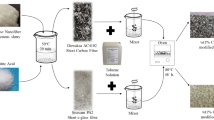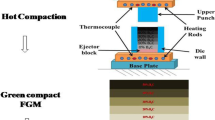Abstract
As a kind of carbon fiber-rich material, the machined surface quality of Cf/SiC composites is greatly affected by the fracture mode of carbon fibers. Therefore, exploring the material removal mechanism of Cf/SiC composites in grinding through the different fracture mechanisms of carbon fibers from the perspective of microstructure is necessary. In research, the micro-scale fracture mechanism of carbon fibers and the transformation of mechanism were explored. The difference in fracture behavior of carbon fibers caused different energy consumption in material removal, which is instructive for monitoring the machining process with specific grinding energy. The difference of machined surface morphology was directly caused by the difference of material removal mechanism, which can be effectively characterized by the machined surface roughness. The transition of the material removal mechanism was determined by the maximum undeformed chip thicknesses. Ultrasonic-assisted grinding promoted the removal of carbon fibers in nano-scale brittle fractures by reducing the maximum undeformed chip thicknesses, thereby improving the quality of the machined surface.

















Similar content being viewed by others
Data availability
The raw/processed data required to reproduce these findings cannot be shared at this time as the data also forms part of an ongoing study.
References
Yin XW, Cheng LF, Zhang LT, Travitzky N, Greil P (2017) Fibre-reinforced multifunctional SiC matrix composite materials. Int Mater Rev 62:117–172. https://doi.org/10.1080/09506608.2016.1213939
Binner J, Porter M, Baker B, Zou J, Venkatachalam V, Diaz VR, D’Angio A, Ramanujam P, Zhang T, Murthy TSRC (2019) Selection, processing, properties and applications of ultra-high temperature ceramic matrix composites, UHTCMCs–a review. Int Mater Rev:1–56. https://doi.org/10.1080/09506608.2019.1652006
Marshall DB, Cox BN (2008) Integral textile ceramic structures. Annu Rev Mater Res 38:425–443. https://doi.org/10.1146/annurev.matsci.38.060407.130214
Chen L, Yin X, Fan X, Chen M, Ma X, Cheng L, Zhang L (2015) Mechanical and electromagnetic shielding properties of carbon fiber reinforced silicon carbide matrix composites. Carbon 95:10–19. https://doi.org/10.1016/j.carbon.2015.08.011
Krenkel W, Heidenreich B, Renz R (2002) C/C-SiC composites for advanced friction systems. Adv Eng Mater 4(7):427–436. https://doi.org/10.1002/1527-2648(20020717)4:7<427::AID-ADEM427>3.0.CO;2-C
Du J, Zhang H, Geng Y, Ming M, He W, Ma J, Cao Y, Li X, Liu K (2019) A review on machining of carbon fiber reinforced ceramic matrix composites. Ceram Int 45(15):18155–18166. https://doi.org/10.1016/j.ceramint.2019.06.112
Ding K, Fu Y, Su H, Chen Y, Yu X, Ding G (2014) Experimental studies on drilling tool load and machining quality of C/SiC composites in rotary ultrasonic machining. J Mater Process Technol 214(12):2900–2907. https://doi.org/10.1016/j.jmatprotec.2014.06.015
Feng P, Wang J, Zhang J, Zheng J (2017) Drilling induced tearing defects in rotary ultrasonic machining of C/SiC composites. Ceram Int 43(1):791–799. https://doi.org/10.1016/j.ceramint.2016.10.010
Diaz OG, Axinte DA, Butler-Smith P, Novovic D (2019) On understanding the microstructure of SiC/SiC ceramic matrix composites (CMCs) after a material removal process. Mater Sci Eng A 743:1–11. https://doi.org/10.1016/j.msea.2018.11.037
Li C, Zhang F, Meng B, Liu L, Rao X (2017) Material removal mechanism and grinding force modelling of ultrasonic vibration assisted grinding for SiC ceramics. Ceram Int 43(3):2981–2993. https://doi.org/10.1016/j.ceramint.2016.11.066
Diaz OG, Axinte DA (2017) Towards understanding the cutting and fracture mechanism in ceramic matrix composites. Int J Mach Tool Manu 118:12–25. https://doi.org/10.1016/j.ijmachtools.2017.03.008
Li Y, Ge X, Wang H, Hu Y, Ning F, Cong W, Ren C (2019) Study of material removal mechanisms in grinding of C/SiC composites via single-abrasive scratch tests. Ceram Int 45(4):4729–4738. https://doi.org/10.1016/j.ceramint.2018.11.165
Zhang L, Ren C, Ji C, Wang Z, Chen G (2016) Effect of fiber orientations on surface grinding process of unidirectional C/SiC composites. Appl Surf Sci 366:424–431. https://doi.org/10.1016/j.apsusc.2016.01.142
Liu Q, Huang G, Xu X, Fang C, Cui C (2017) A study on the surface grinding of 2D C/SiC composites. Int J Adv Manuf Technol 93(5-8):1595–1603. https://doi.org/10.1007/s00170-017-0626-1
Ding K, Fu Y, Su H, Cui F, Li Q, Lei W, Xu H (2017) Study on surface/subsurface breakage in ultrasonic assisted grinding of C/SiC composites. Int J Adv Manuf Technol 91(9-12):3095–3105. https://doi.org/10.1007/s00170-017-0012-z
Qu S, Gong Y, Yang Y, Wen X, Yin G (2019) Grinding characteristics and removal mechanisms of unidirectional carbon fibre reinforced silicon carbide ceramic matrix composites. Ceram Int 45(3):3059–3071. https://doi.org/10.1016/j.ceramint.2018.10.178
Chen J, An Q, Chen M (2020) Transformation of fracture mechanism and damage behavior of ceramic-matrix composites during nano-scratching. Compos A Appl Sci 130:105756. https://doi.org/10.1016/j.compositesa.2019.105756
Malkin S, Guo C (2008) Grinding technology: theory and application of machining with abrasives. Industrial Press, New York, pp 54–59
Xu HHK, Jahanmir S, Ives LK (1997) Effect of grinding on strength of tetragonal zirconia and zirconia-toughened alumina. Mach Sci Technol 1(1):49–66. https://doi.org/10.1080/10940349708945637
Li C, Li X, Wu Y, Zhang F, Huang H (2019) Deformation mechanism and force modelling of the grinding of YAG single crystals. Int J Mach Tool Manu 143:23–37. https://doi.org/10.1016/j.ijmachtools.2019.05.003
Yang F, Hu G, He H, Yi M, Ge Y, Ran L, Peng K (2019) Effect of amorphous carbon on the tensile behavior of polyacrylonitrile (PAN)-based carbon fibers. J Mater Sci 54(11):8800–8813. https://doi.org/10.1007/s10853-018-03256-z
Li C, Wu Y, Li X, Ma L, Zhang F, Huang H (2020) Deformation characteristics and surface generation modelling of crack-free grinding of GGG single crystals. J Mater Process Technol 279:116577. https://doi.org/10.1016/j.jmatprotec.2019.116577
Funding
The work is supported by National Natural Science Foundation of China [grant number 51975368].
Author information
Authors and Affiliations
Corresponding author
Additional information
Publisher’s note
Springer Nature remains neutral with regard to jurisdictional claims in published maps and institutional affiliations.
Rights and permissions
About this article
Cite this article
Chen, J., An, Q., Ming, W. et al. Investigation on machined surface quality in ultrasonic-assisted grinding of Cf/SiC composites based on fracture mechanism of carbon fibers. Int J Adv Manuf Technol 109, 1583–1599 (2020). https://doi.org/10.1007/s00170-020-05739-3
Received:
Accepted:
Published:
Issue Date:
DOI: https://doi.org/10.1007/s00170-020-05739-3




